Chapter 9. Cold War Canada, 1945-1991
9.5 Post-War Leadership and State-making
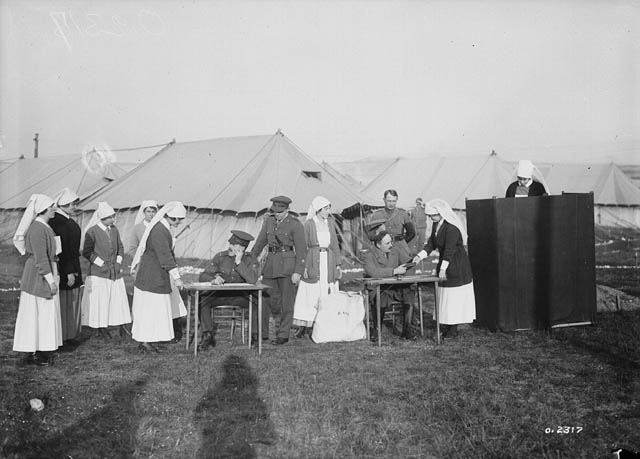
It is easy to misapprehend Canadian politics as an arena in which the rules are stable and the participants are easy to identify. Politics, ultimately, is about power, who shares in it, and how it is divided up among those participants. When Canada was created as a constitutional entity in 1867, it was with a particular body politic in mind. Fifty years later, much about that political realm had changed. A century later, and it would have been unrecognizable to the nation’s founding generation.
The Elect, the Electorate, and the Elected
There are several dimensions to political life and how it evolves, among which we can include participation. As we have seen (in Chapter 3 and elsewhere), the limits of democracy were far greater in 1867 than any tendency toward inclusiveness. The most dramatic changes in the franchise came in the 20th century. Universal male suffrage was still tightly constrained: Asians and most Aboriginal peoples could not vote, and property requirements ensured that many working men could not vote, as well. Rounding out race and class as restrictions on the franchise was, of course, gender. Women were unable to vote provincially and federally until the 1910s and, when the breakthrough came, the franchise only included women who fit the racialized categories of citizenship. Restrictions against the female franchise in Quebec until 1940 impacted women’s federal voting rights because the province maintained both the provincial and federal voters list until the 1930s. Clearly, the move toward greater democratic rights was not a one-way street; rather, it was a highway with a passing lane and room for parking on the shoulder.
The Dominion Elections Act (1920) made women’s suffrage a permanent arrangement rather than a temporary, wartime expedient. It also created the office of the Chief Electoral Officer and insulated it from the pressures of patronage politics. Preparation of voters lists, the enforcement of rules for behaviour on election day, and responsibility for promoting awareness of electoral rights and polling station locations created a more level and consistent playing field for politics at the federal level, though not overnight. Most provinces quickly followed this example. By the 1940s, the formal property qualifications for the federal franchise had been excised, and transient working people were thereby brought into the electorate.
Even as these improvements were being made for some, democracy’s welcome mat was being pulled in for others. The 1920 Act allowed provinces to exclude voters “for reasons of race.” British Columbia’s legislators decided repeatedly to block Asian immigrants from the polls and were successful; Chinese settlers in Saskatchewan suffered the same fate. During the Japanese-Canadian internment of 1942 to 1945, British Columbians of Japanese ancestry carried the question of their exclusion as they were moved to other provinces. While federal politicians were generally prepared to turn a blind eye to British Columbian racism, they were less happy when it was brought to their own doorstep. Nevertheless, wartime fears of the Japanese Empire were enough to ensure that racist barriers to Asian-Canadian suffrage persisted. Reforms in 1947 actually worsened matters by disenfranchising Doukhobors, Hutterites, and Mennonites ostensibly for their pacifism (members of these communities who served in the military were exempt from the Act’s provisions). The good news in 1947 was that the Chinese-Canadian community was enfranchised; a year later, the Japanese-Canadian community won the federal vote and in 1949, the British Columbia vote.
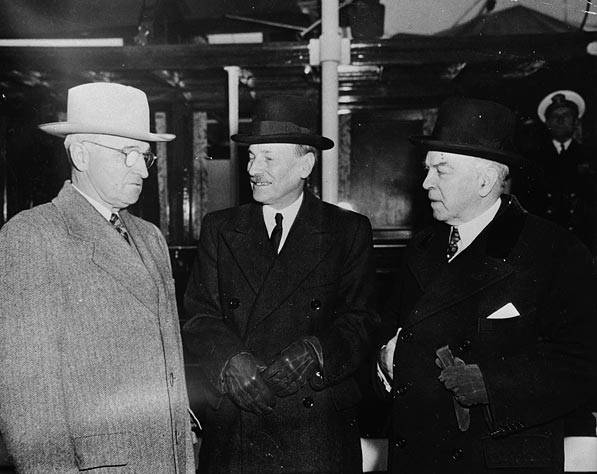
By 1950, only two identity groups lacked the vote: some members of the pacifist/communal communities and Status Indians. Legislation in 1955 removed religious beliefs as cause for electoral discrimination. In 1960, the Canadian Bill of Rights extended the vote to all adult Aboriginals. Not all First Nations communities were enthusiastic supporters of the franchise. British subjecthood and, after 1947, Canadian citizenship and electoral rights had always implied or entailed some loss of Aboriginal autonomy and identity. Indeed, many of the public and legislative debates on this topic revolved around the assimilative prospects of the franchise. The rights granted in 1960, however, were presented as an unconditional opportunity and were broadly accepted.[1]
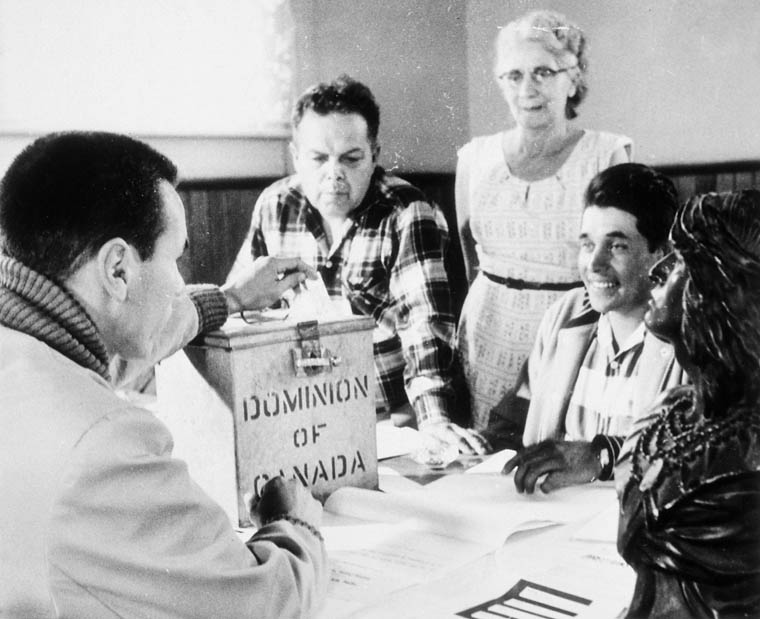
Who was left to enfranchise? Prisoners in Canada’s penal system were excluded, as were the judges who sent them to prison. Some Canadians with mental disabilities were not allowed to vote. Reforms in 1993 responded to the existence of the new Charter of Rights by removing barriers to judges, people with mental disabilities, and prisoners serving sentences of two years or less. At the time of writing, the largest group left without the franchise is the non-adult population. It is worth considering that many of the arguments made, successively, against giving the vote to working men, women, and Aboriginal peoples — that they were insufficiently informed or knowledgeable on political matters, subject to pressures from authority figures, and probably not interested in getting the vote notwithstanding a few loud agitators, suffragettes (and so on) — are often the very same objections raised against enfranchising non-adults.
Mackenzie King’s Secret Life
Christopher Dummitt, School for the Study of Canada, Trent University
No other prime minister has ever been as successful as William Lyon Mackenzie King (1874-1950). No other prime minister has ever been as strange.
The first claim is undoubtedly true. Mackenzie King governed the country for almost 22 years beginning in 1921 and lasting until 1948, with only two periods out of office — briefly in 1926 and then from 1930 to 1935. This isn’t only a Canadian record. It’s the longest time in office of any leader of a parliamentary democracy. But was he also very odd?
This is what many Canadians came to think about “Weird Willie” Mackenzie King. While he was alive, he was never very popular. He was not a great orator nor did he look the part of the great statesman. Yet Mackenzie King was a shrewd and intuitive political leader who, time and time again, seemed to best grasp what the largest share of the Canadian public wanted. At the time of his death in 1950, the newspapers memorialized Mackenzie King as a “great Canadian.”
Only weeks after his death, the newspapers were also reporting that Mackenzie King had been a spiritualist. That is, they claimed that he believed that he could communicate with ghosts. Over the years, more and more stories emerged about how he had consulted mediums to speak to his dead mother and grandfather and the ghosts of his political idols and former opponents. When his diaries were opened up to the public in the 1970s, they seemed to show a man who had lived a double life; publicly, he was a staid politician but privately, he engaged in the oddities of the occult. The diaries also revealed, some historians claimed, that the bachelor prime minister had visited prostitutes as a young man and then returned home to confess guiltily to his diary. Novelists and poets picked up on the figure of “Weird Willie” and he showed up in novels, poetry, and plays — he even earned his own CBC television miniseries.
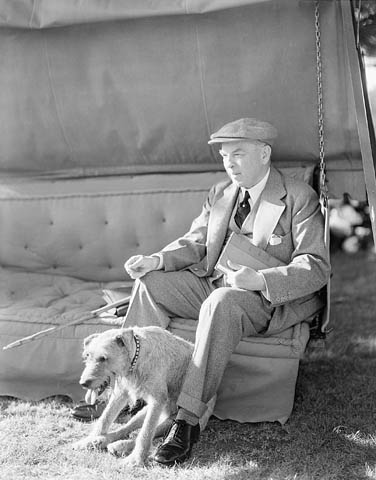
Other historians have challenged the accuracy and usefulness of this idea of our most successful prime minister as a ghost-talking, sex-trade client. Yet whatever side one takes, perhaps the most interesting conclusion we can reach about the “Weird Willie” phenomenon is to think about why it happened at all. The popularity of this idea of Mackenzie King having led a secret life tells us something about him, but it also tells us about Canadian culture and politics in the years after he died.
At the time of Mackenzie King’s death in 1950, journalists and historians could have known about his private life but chose not to delve too deeply into it. They remained deferential to the privacy of a statesman. Indeed, a 1949 biography of Mackenzie King even mentioned his interest in what he called psychic research. Yet no journalists followed up on these revelations.
If we fast-forward to the mid-1970s, Canadians were lining up to buy books about his double life that exposed the allegedly lurid details of his sex life and his mystical beliefs. It wasn’t only that new information had emerged, something else had happened too: Canadian political culture had become much less deferential. Journalists and citizens demanded more of their political figures. As a result of the sexual revolution of the 1960s, some parts of life that had been considered out of bounds — like speaking about someone’s sex life — were no longer taboo. What the ghost of Mackenzie King found out is that this new openness and frankness applied even to dead politicians.
When we think about Weird Willie and his secret life, we are actually learning about two historical eras. The first is the era in which King lived. The second is the years after Mackenzie King died, the postwar decades. The transformation in Canadian values in these years led journalists and the public to want to lay bare the secret lives of those who governed them.
Additional Readings
C P Stacey, A Very Double Life: The Private World of Mackenzie King (Toronto: Macmillan, 1976).
Michael Bliss, Right Honourable Men: The Descent of Canadian Politics from Macdonald to Chretien (Toronto: Harper Perennial, 2004).
Christopher Dummitt, The People Unfooled: Mackenzie King’s Secret Life and the Making of an Irreverent Democracy (Montreal and Kingston: McGill-Queen’s University Press, forthcoming).
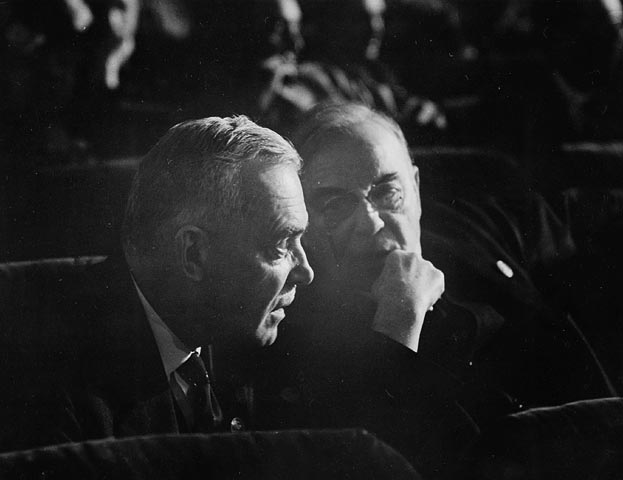
Uncle Louis
Of all the 20th-century governments, it is probably easiest to undervalue the importance of the St. Laurent administrations. Louis St. Laurent (1882-1973) does not appear on Canadian currency. He was charismatic, but in an understated and avuncular way (unlike Diefenbaker and Trudeau, who followed him). He was not — even though perhaps he should have been — a Nobel Prize winner (unlike his successor at the head of the Liberal Party, Lester B. Pearson), and he only (only!) held office for a decade, unlike his exceptional predecessor, Mackenzie King. And yet remarkable things were accomplished under St. Laurent, and that first Cold War decade decided much about the rest of the 20th century for Canada.
St. Laurent inherited the Prime Minister’s Office (PMO) from Mackenzie King and led the Liberals to their largest majority ever in 1949. He did comparably well in 1953. The Liberals oversaw economic and governmental expansion of a kind that was unparalleled before and after St. Laurent’s mandate. The economy rebounded from the postwar doldrums and emerged from the Korean War in better shape than when it went into it.
What’s more, St. Laurent personally changed the political culture in that he humanized the role of leader. He was old: when he took over the PMO, he was already 66, the oldest person to enter the position ever. Perhaps because he came to the job late in life he lacked the stuffiness of Bennett, the careerism of King, or the hustle of Diefenbaker. Indeed, St. Laurent was known to ignore voters and journalists if there were children nearby with whom he could chat instead, for which he earned the epithet, “Uncle Louis” in English Canada, and “Papa Louis” in French Canada.
Nevertheless St. Laurent’s peers described him as effective and intellectually sharp. His critics thought that he was obsessively anti-communist and too quick to involve Canada in the wider world. St. Laurent would probably plead guilty to both charges. He played a leading role in the creation of NATO, established permanent Canadian bases in West Germany, took Canada into the anti-communist war in East Asia, committed resources to the Pinetree and Mid-Canada radar defence lines, and contributed significantly to Canada’s role in negotiating a diplomatic solution to the Suez Crisis in 1956.
St. Laurent’s worldview must have been formed decades earlier but his anti-communist instincts were sharpened by the 1946 Gouzenko Affair. St. Laurent’s actions in these years speak to a Cold War-era fear of the Soviet Union and concern that small wars — Korea and the Israel-Egypt conflict — could lead to full-blown nuclear holocausts. Like King, he envisioned Canada occupying the position of middle power, playing a critical role and brokering peace between high-flying superpowers and the major powers. As well, he saw a role in building an alliance of like-minded nations with comparable influence. To that end, he championed the cause of an inclusive Commonwealth that went beyond the so-called “White Dominions” and included India (led in these years by its first post-independence prime minister, Jawaharlal Nehru) and other emergent colonies in Asia and Africa. While he advanced these arguably progressive objectives, St. Laurent in 1949 oversaw the wholesale purge of left-wingers in the National Film Board.[2]
In terms of social policies, St. Laurent’s administration promoted the agenda of the postwar settlement and the welfare state. All Canadians over 70 years of age would get pensions; those over 65 were eligible for assistance. The government pushed the provinces, too, with respect to post-secondary education and healthcare. Investments in infrastructure were part of Ottawa’s job-creation plan, and it was under St. Laurent that the St. Lawrence Seaway, the Trans-Canada Pipeline, and the Trans-Canada Highway were completed. In this respect, St. Laurent inherited from King a political environment that included social democratic, agrarian socialist, and populist Social Credit traditions and parties.[3] Holding the middle ground by borrowing from both sides was a Liberal Party practice that St. Laurent’s regime refined.
St. Laurent’s anti-Soviet position inevitably brought him closer to the United States, something about which some Canadians were conflicted and to which others were adamantly opposed. What would have inflamed opinion among the latter group was the Prime Minister’s role in the Suez Crisis. Britain (along with France and in support of Israel) had blundered into an attempt to capture the Suez Canal. This took place just as the Americans were protesting the Soviet Union’s suppression of the Hungarian Uprising of 1956. Embarrassed by the timing of the British military expedition against Egypt and fearing Soviet reprisals against NATO partners in Western Europe, the Americans took a highly critical stance of Britain. For Canada to stand by while Britain was effectively at war was one thing; for Canada to side with the Americans against Britain was entirely another.
This was, in many respects, continuity rather than rupture. Mackenzie King had always been closer to the United States than to the United Kingdom. Ogdensburg certainly confirmed that. Mackenzie King’s so-called Minister of Everything, C.D. Howe (1886-1960), was also St. Laurent’s chief planner and carried on through these crises as though it was still 1943. Anti-American feeling, concern that members of the Liberal Party were getting fat off of government contracts, and worn out by more than a decade of Howe’s steamroller approach to getting projects done, Canadians took a renewed interest in the option of voting Conservative, especially as that party had found a new, charismatic leader in John Diefenbaker.
Exercise: Documents
“Do nothing by halves which can be done by quarters.” (F.R. Scott, “W.L.M.K.”)
Mackenzie King’s diaries survived incineration almost by chance, and we are so much richer for it. He was assiduous in maintaining a journal and surprisingly frank. And sometimes odd. Any kind of coincidence caught his attention and he filled it with meaning. The hands of a clock both at 12, the recurrence of a colour, similarities in names — they all signaled to him some higher force at work.
No other public figure in the history of Canada left us such an extensive record of their private thoughts on both personal and public matters.
Mackenzie King’s careful notebooks were transcribed in typescript, beginning in 1950. These are only partial when compared to the original. Nonetheless, they present surprising detail. In December 1944, while the world was at war, Mackenzie King had a night of interrupted sleep. In the middle of the night, he recorded his recollection of a disturbing dream. In the morning, he receives news of still more psychic events in Montreal. Are these the ramblings of an exhausted prime minister, or do they reveal something of the inner workings of the early 20th century, modern mind?
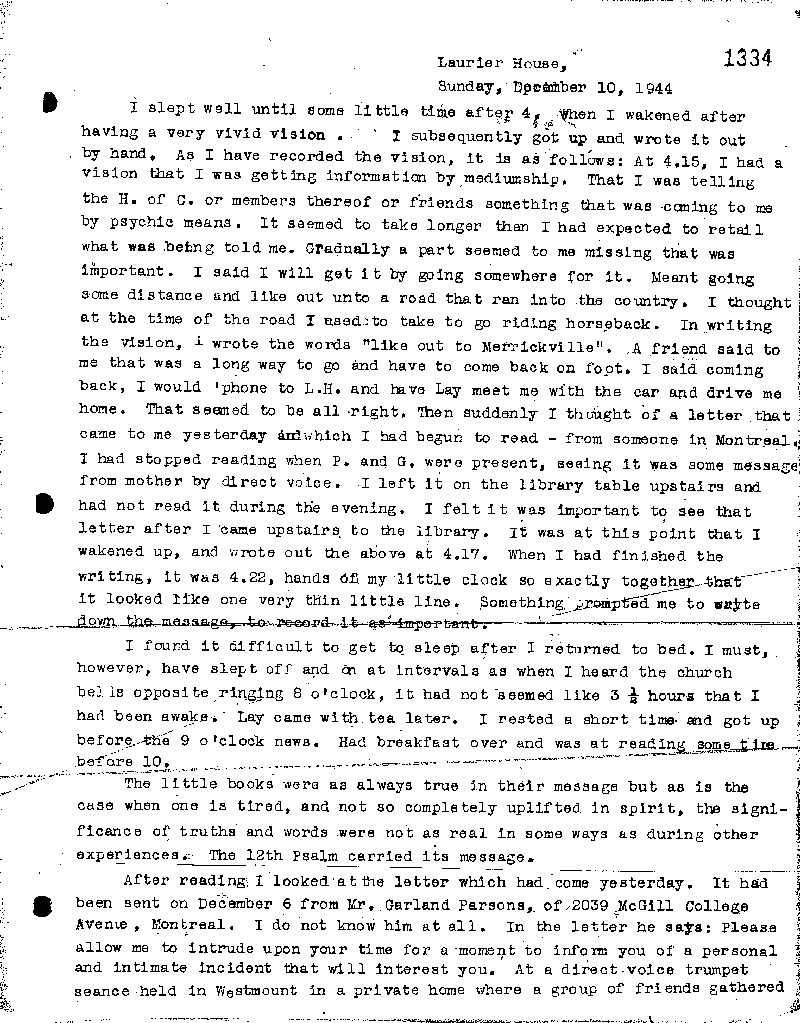
Key Points
- Changes in the democratic franchise continued to be made (federally and provincially) in the mid-20th century, mostly tending toward greater inclusiveness, but there were significant reversals as well, principally based on race and pacifism.
- Mackenzie King’s complex and extensive secret life of spiritualism, seances, and superstition was kept under the public radar because of greater deference shown to political leaders at the time.
- The postwar boom was ushered in by the Liberals under Louis St. Laurent — a decade that saw Canada become active in global diplomacy, counter-espionage, communist hunts, and massive infrastructure projects.
Long Descriptions
Figure 9.E1 long description: Typeset page from William Lyon Mackenzie King’s diary. It is dated Sunday, December 10, 1944, at Laurier House. It reads:
“I slept well until some little time after 4, when I wakened after having a very vivid vision. I subsequently got up and wrote it out by hand. As I have recorded the vision, it is as follows: At 4.15, I had a vision that I was getting information by mediumship. That I was telling the H. of C. or members thereof or friends something that was coming to me by psychic means. It seemed to take longer than I had expected to recall what was being told me. Gradually a part seemed to me missing that was important. I said I well get it by going somewhere for it. Meant going some distance and like out unto a road that ran into the country. I thought at the time of the road I used to take to go riding horseback. In writing the vision, I wrote the words ‘like out to Merrickville’. A friend said to me that was a long way to go and have to come back on foot. I said coming back, I would ‘phone to L.H. and have Lay meet me with the car and drive me home. That seemed to be all right. Then suddenly I thought of a letter that came to me yesterday and which I had begun to read — from someone in Montreal. I had stopped reading when P. and G. were present, seeing it was some message from mother by direct voice. I left it on the library table upstairs and had not read it during the evening. I felt it was important to see that letter after I came upstairs to the library. It was at this point that I wakened up, and wrote out the above at 4.17. When I had finished the writing, it was 4.22, hands of my little clock so exactly together that it looked like one very thin little line. Something prompted me to write down the message, to record it as important.”
“I found it difficult to get to sleep after I returned to bed. I must, however, have slept off and on at intervals as when I heard the church bells opposite ringing 8 o’clock, it had not seemed like 3½ hours that I had been awake. Lay came with tea later. I rested a short time and got up before the 9 o’clock news. Had breakfast over and was at reading some time before 10.”
“The little books were as always true in their message but as is the case when one is tired, and not so completely uplifted in spirit, the significance of truths and words were not as real in some ways as during other experiences. The 12th Psalm carried its message.”
“After reading I looked at the letter which had come yesterday. It had been sent on December 6 from Mr. Garland Parsons, of 2039 McGill College Avenue, Montreal. I do not know him at all. In the letter he says: Please allow me to intrude upon your time for a moment to inform you of a personal and intimate incident that will interest you. At a direct voice trumpet seance held in Westmount in a private home where a group of friends gathered …” [Return to Figure 9.E1]
Media Attributions
- Nursing Sisters at a Canadian Hospital voting in the Canadian federal election © William Rider-Rider, Canada Dept. of National Defence, Library and Archives Canada (PA-002279) is licensed under a Public Domain license
- President Harry Truman and Rt. Hons. Clement Attlee and Mackenzie King boarding U.S.C.G. SEQUOIA for discussions about the atomic bomb © Library and Archives Canada (C-023269) is licensed under a Public Domain license
- In Hiawatha Council Hall on occasion of federal by-election © Nick Nickels, Library and Archives Canada (PA-123915). Copyright Government of Canada. No restrictions on use.
- Rt. Hon. W.L. Mackenzie King with his dog Pat I at Moorside Cottage, 1940 © Yousuf Karsh, Library and Archives Canada (PA-174051) is licensed under a Public Domain license
- Rt. Hon. W.L. Mackenzie King and Hon. Louis St. Laurent at the United Nations Conference on International Organization © Nicholas Morant, National Film Board of Canada. Phototheque, Library and Archives Canada (C-022717) is licensed under a Public Domain license
- Page of Prime Minister King’s Journal, 1944 © W.L. Mackenzie King is licensed under a Public Domain license
- A useful survey of the franchise can be found at Elections Canada, “A History of the Vote in Canada”, http://www.elections.ca/content.aspx?section=res&dir=his&document=index&lang=e, accessed 22 December 2015. ↵
- Reg Whitaker and Steve Hewitt, Canada and the Cold War: The Making of a National Insecurity State, 1945-1957 (Toronto: James Lorimer & Co., 2003), 10. ↵
- Alvin Finkel, Our Lives: Canada After 1945 (Toronto: James Lorimer & Company, 1997), 6-7. ↵
Also the Office of the Prime Minister or the PMO; the centre of political decision making in the Parliamentary system, consisting of the Prime Minister and her/his chief political advisors; in Ottawa, located in the Langevin Block on Parliament Hill.
The idea that Canada might occupy a position between "great power" states like Britain and the United States and, after the World War II, at a level between the superpowers (the US and the USSR), the second tier of military and economic powers (e.g.: Britain and France), and other nations; tied to Lester Pearson's vision of peacekeeping and Canada as a referee or fair broker.

